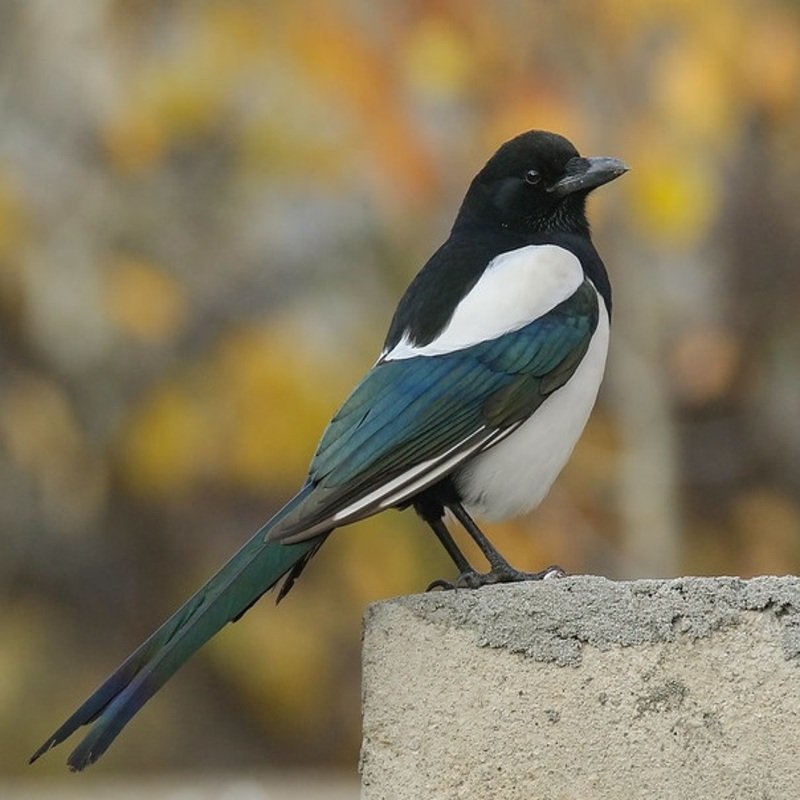The black-billed magpi, Pica hudsonia alternatively known as the American magpie, is a Corvidae bird that is found in western North America. It is one of only four songbirds in North America with a tail that is at least half the length of the rest of the body.
Quick Overview: Pica Hudsonia – Black-billed Magpie
Body size: Around 17.5-22 in (44-56 cm) and a weight of 187 g (6.6 oz)
Main colors: Black, White, Green, Bronze
Range: Northwestern United States
Migratory Bird: No
Best time of the year to see in the U.S.: All Year (January – December)
Conservation Status: Least Concern
Black-billed Magpie Description
Magpies with a black beak are medium-sized birds with a long tail that can account for up to half of their length. Magpies with a black bill weigh between 145 and 210 grams. Black is used on the head, upper breast, back, and tail. On the wings and lower breast, there are big areas of white. Their bills are large and black, as are their legs. At a distance, black-billed magpies are predominantly black and white, but their tail, body, and wings are covered in brilliant iridescent patches ranging from bronze to green. While both sexes have a similar color, females are around 10% less in size than males.

Size
These birds have a length of 17.5-22 in (44-56 cm) and a weight of 187 g (6.6 oz). Their wings could range from 24 in (61 cm).
Feeding
Like other corvids, black-billed magpies are opportunistic omnivores. They frequently graze on the ground, and their diet may be inferred in part from the little pellets they vomit shortly after feeding. They feed mostly on insects and their larvae, as well as songbird eggs and hatchlings. Additionally, they consume fruit and grain crops, as well as small animals like mice and meadow voles. Black-billed magpies forage for carrion and are frequently spotted eating at roadkill and human garbage along roadsides. To store food, black-billed magpies create little depressions in the ground or snow.
Habitat
Black-billed magpies like rangeland and forested areas with open fields, which are typically located near bodies of water. Foraging requires wooded habitats and shrubby thickets for nesting and as a method of escape if chased, whilst meadows and clearings are utilized for foraging. The other habitat requirement is robust trees and bushes capable of supporting their quite large nests. These requirements are typically satisfied in riparian and edge habitats. These same characteristics apply to farmland and agricultural areas, which make rural human populations an appropriate home. Scavenging chances exist in agricultural regions as well, such as open compost piles.
Behavior
Black-billed magpies have a strutting stride and regularly hop before taking flight. Horizontal flight is often characterized by slow, constant wing beats, but descending flight is characterized by a brief sequence of wing flaps interspersed with pauses during which the wings are tucked tightly to the body. This alternating rhythm results in an evocative J-shaped flight path.
Pica Hudsonia Scientific Classification
- Kingdom: Animalia
- Phylum: Chordata
- Subphylum: Chelicerata
- Class: Aves
- Order: Passeriformes
- Family: Corvidae
- Genus: Pica
- Species: Pica hudsonia
Other common names
Also known as the American magpie.
Best time of the year to see
In the United States, the best time of year to see these birds is all year round, regardless of the season. This refers to any month of the year between January and December.
Distribution of the Black-billed Magpie in the USA
From southern Alaska through western and central Canada, south to northern California, and west over the Great Plains, this species is a resident. It may go as far east as Ontario and Minnesota during the winter months.
The Black-billed Magpie can be found in the following states in the United States – Montana, Oregon, Washington, North Dakota, South Dakota, Nebraska, Idaho, Kansas, Nevada, Utah, Colorado, New Mexico, Texas, and Wyoming.
